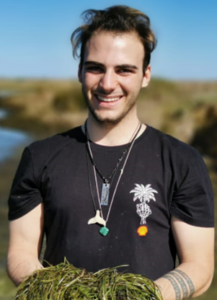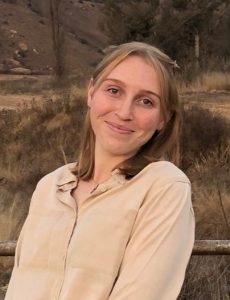MSc Students

Nosipho Gqaleni
Department of Botany and Zoology
Nosipho is studying the seasonal patterns of rainfall, soil moisture and related ecosystem water use efficiency in a semi-arid Nama Karoo landscape comprised of dwarf C3 shrubs and C4 grasses. Her study focuses on determining whether the soil moisture regime and related vegetation evapotranspiration response in the Eastern-Karoo is driven by rainfall seasonality or by specific rainfall events. She aims to describe the seasonal patterns of ecosystem evapotranspiration and determine the most efficient model to predict evapotranspiration from climatic data. She will also be developing a bucket model for this system to simulate soil moisture patterns at two depths. Her study intends to fill the knowledge gap about soil moisture regimes and ecosystem evapotranspiration in this semi-arid region.

Yenziwe Mbuyisa
Department of Botany and Zoology
Yenziwe is an environmental scientist honours graduate from Rhodes University. Her interest in tree physiology and climate change have lead her to pursue a masters degree, in collaboration with Professor David Drew from the department of Foresrty and Wood science and the Eucxylo Group, looking at the effects of temperature and water availability on the water use efficiency and C isotopic discrimination of two myrtacea species, Eucalyptus grandis and Syzyguim guineense. This project is in response to the increasing movement of climate change mitigation through global tree afforestation/reforestation programs. With the likelihood of increasingly frequent and severe droughts and heat waves being a major cause for concern, understanding how trees respond to temperature extremes and limited water availability is critical to forecasting both short and long-term impacts of climate change on forest systems in South Africa.

Gerhard Wiese
Department of Botany and Zoology
Gerhard is a MSc student within the CL•I•M•E research group focusing on lizard physiology, specifically temperature effects on their rates of water loss. Using flow-through respirometry he is measuring the amount of water vapor expelled through the skin and the respiratory system of the lizards. He is also aiming to determine how the partitioning of water loss differs with increasing ambient temperatures. Physiological studies, such as those measuring the temperature sensitivity of water loss rate, are important for understanding how these organisms respond to environmental conditions experienced in nature. Relating these water loss rates to temperature and body size will provide key information for enhancing predictive mechanistic models of vulnerability of lizards to climate change.

Olivia Jones
Department of Botany and Zoology
Olivia is in the first year of her Master’s Degree in Botany. Her research project “Megaherbivore trophic rewilding for top down herbivore control: A test-case in a semi-arid savanna.” will combine remote sensing techniques with field and lab data to investigate what impact megaherbivore rewilding has had on the vegetation structure in the semi-arid savanna region of Tswalu Kalahari Reserve, South Africa. This study will contribute to the field of trophic rewilding by providing the hypothesis testing and science-based monitoring approaches called for in the literature. It is pertinent that this study is being conducted in a savanna, as the ecosystem services provided by this biome are threatened by processes that have come about, in part, from loss of herbivore guilds, such as bush encroachment.

Aisha Rifai
Department of Botany and Zoology
Aisha’s research project “Vegetation and predator-prey dynamics at the Tswalu Kalahari Reserve, in the South African savanna.” is an expansion of her honour’s project, which looked at the influence of lions on the vegetation productivity at the Tswalu Kalahari Reserve (TKR). But unlike the honour’s project, which was a complete remote study, this project will incorporate a hybrid approach consisting of remote sensing (RS) and fieldwork to assess the impact of predation by lions on vegetation growth. A 20-year period will again be investigated via RS methods. The RS portion will focus on environmental aspects, including vegetation index, drought index, fire and carbon influxes, and the changes in land use. The fieldwork will incorporate Landscape of Fear (LoF) modeling to quantify the effect lions exert on prey species. The main aim of this study is to statistically demonstrate the significance the presence of lions has on vegetation in a reserve. This information is vital in understanding the role predators play as ecosystem health indicators, and especially to reserves when reintroducing predators.

Josh Smit
Department of Botany and Zoology
I am originally from Zimbabwe and attended Falcon College for high school. Later, I pursued my undergraduate and Honours degrees at the University of Pretoria. My Honours Project focused on how Nile Crocodiles respond behaviourally to changes in their external environment, and what temperature changes determines their micro- and macro-scale movements. I have since relocated to pursue my Master’s degree at Stellenbosch University, under the supervision of Prof Susana Clusella-Trullas.
My research will focus on the relationship between integument colour, body temperature, and behavioural thermoregulation in a cordylid species in the Western Cape, South Africa. I aim to uncover how short and long-term temperature changes influence melanin-driven colour patterns. By examining coastal and inland populations, my project seeks to expand previous findings and understand colour variation across different environments. Using refined experimental methods, including marking individuals for longitudinal studies, my research also aims to provide insights into how ectotherms adapt to environmental cues. Ultimately, it contributes to understanding colour variation and its adaptive significance in response to dynamic environments.

Aidan Bossert
Department of Botany and Zoology
I am a blue carbon and seagrass researcher focussed on understanding the potential for blue carbon ecosystems, particularly seagrasses, to act as pertinent climate change mitigants. Blue carbon is the collective term for carbon sequestered in vegetated coastal zones such as salt marshes, mangroves and seagrasses. This carbon storage capacity is invaluable in the fight against climate change, as even given their small distributional area, blue carbon ecosystems are responsible for storing more than 50% of the carbon accumulated in the world`s oceans. Currently, my work aims to evaluate the carbon capturing potential of the seagrass meadows present in the Langebaan lagoon, Western Cape. This information will be useful for the establishment of a Langebaan seagrass blue carbon budget, for use in future carbon offset and carbon trading schemes. Additionally, I will be attempting to establish a baseline method for upscaling and improving seagrass restoration projects in South Africa, which I hope will provide a fundamental guideline for successful future restoration projects.

Tiaan Engelbrecht
Department of Botany and Zoology
Tiaan is a Master’s student in the department, with his studies mainly focussed on the coastal vegetated ecosystems found along South Africa’s coastline. These coastal vegetated ecosystems include mangroves, salt marsh, and seagrass, and are widely known as blue carbon ecosystems as they capture and store atmospheric carbon in their belowground sediment. His project is focused on salt marsh and seagrass habitats in the Olifants River Estuary on the west coast of South Africa. More specifically, his project entails the measurement and quantification of organic carbon stocks within the sediments of these two vegetation types. Along with measuring the carbon stocks, his project aims to determine the factors that contribute to the variability of carbon stocks across small (0-15 m), medium (50-150 m), and larger (1-3 km) scales, as well as the seasonal variation associated with the carbon stocks. The seagrass species incorporated in his study, Z. capensis, is the dominant seagrass species in South Africa, and is also an endangered species. His study intends to contribute to the limited research and lack of knowledge regarding carbon storage and variability between vegetation types in South Africa, and provide carbon stock estimates required for future carbon budgets. An interesting addition to his project, is the incorporation of subtidal seagrass meadows, which hasn’t been done in previous studies due to difficulty of sampling and accessibility.

Jessica Howard
Department of Conservation Ecology and Entomology, Centre for Invasion Biology
I am a MSc student in Conservation Ecology at Stellenbosch University with a strong background in the Proteaceae family. I completed my undergraduate (Botany and Zoology) and BSc Hons degree (Botany) at The University of Johannesburg where I worked on two Proteaceae related projects, one of which was an independently developed honours research project. These projects helped me develop my love and passion for this family and their amazing adaptations and structures, which ultimately led me to the Western Cape. My research focuses on the Fynbos biome, which is a biodiversity hotspot. Here, ecosystem functioning strongly depends on shrubs of the genus Protea. The recruitment (the transition from seed to established plant) phase of these plants’ life cycle is the most vulnerable, and recruitment strategies differ between genotypes from different environments which are driven by natural selection. Understanding this differentiation in recruitment is crucial in determining how climate change will impact plant population and community dynamics as well as biodiversity. Once understood, conservation management strategies can be developed to mitigate these impacts. To address these challenges, my current project studies the functional and evolutionary determinants of recruitment differentiation between Fynbos Protea individuals, populations, and species. This research makes use of a large common-garden experiment where seeds from 959 mother plants of 195 populations and 18 species were planted. I am using this experiment to quantify variation in germination, performance and functional traits of the Protea seedlings. This MSc is the first of many planned projects, as monitoring of the plants is planned for a minimum of 10 years, aiming to provide long-term data that will contribute to climate change and conservation management research.
